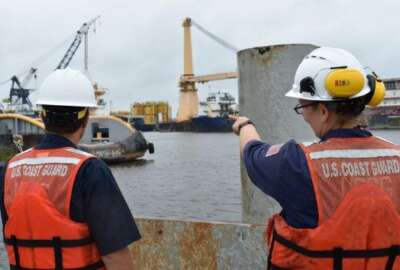
With readiness concerns rising, Coast Guard gets flat budget for 2022
A majority of the budget goes to maintaining and recapitalizing systems, including IT.
Despite issues with readiness and the need for some new ships, the Coast Guard may have to navigate 2022 with a mostly flat budget.
The Biden administration is proposing a $13.1 billion budget for the Coast Guard, which amounts to a slight $300 million increase compared to what Congress appropriated for the service in 2021. About $11 billion of that will be for discretionary funding, and $2 billion will be for mandatory spending, fees and trust funds.
The Coast Guard has long been pushing for more funding to keep up with the demands of the service. Some of its vessels are more than 50 years old and it services the nation’s only functioning icebreaker — the 44-year-old Polar Star.
The often-neglected military branch is expecting to see increased activity in arctic regions as the icecaps continue to melt and as Russian ships increase their presence in the area.
“More than ever, the nation needs a ready Coast Guard with the tools and support system to address complex maritime challenges,” Coast Guard officials wrote in the 2022 budget documentation. “In a world of emerging great power competition, the Coast Guard’s unique capabilities, global operations, and broad ranging partnerships support rules-based order, strengthen partner capacity, and facilitate the free flow of commerce that is essential to the prosperity of the nation.”
The budget pays for a 2.7% increase for service members and civilians.
About $1.6 billion is allocated for procurement, construction and improvements. The Coast Guard is in the midst of its largest program recapitalization effort since the 1940s.
About $1 billion of the procurement funds will go to the continued acquisition of ships. For example, $170 million will go toward the construction of two polar security cutters, the ships that will act as the next icebreakers, and the start of a third cutter.
Another $600 million is going to offshore patrol cutters. The offshore patrol cutters are the Coast Guard’s highest procurement priority, and it plans on building 25 of them by the end of the program.
“The cutters will provide the majority of offshore presence for the Coast Guard’s cutter fleet, bridging the capabilities of the 418-foot national security cutters, which patrol the open ocean, and the 154-foot fast response cutters, which serve closer to shore,” according to the Coast Guard’s acquisition profile of the program. “The cutters will conduct missions including law enforcement, drug and migrant interdiction, search and rescue, and other homeland security and defense operations.”
The service is also investing $15 million in extending the Polar Star’s life.
The Coast Guard will spend $21.5 million on upgrading command, control, communications, computers, cyber and intelligence capabilities as well.
The Coast Guard is asking for $9 billion in operations and support to maintain current programs and restore some of its readiness.
Readiness investments will add more than 600 new full-time employees.
About $92 million will go to additional crew and support for intelligence systems across the nation.
Nearly $100 million will go toward aviation readiness. The Coast Guard wants $12 million to establish a third cyber protection team to work with cyber specialists at critical ports of entry.
More than $80 million will go to IT modernization to replace obsolete equipment and harden systems against cyber attacks.
The Coast Guard is also planning on decommissioning some legacy systems, which will save about $70 million. It will offload C-130H long range surveillance aircraft, Island Class patrol boats and Marine Protector Class patrol boats.
Copyright © 2025 Federal News Network. All rights reserved. This website is not intended for users located within the European Economic Area.
Scott Maucione is a defense reporter for Federal News Network and reports on human capital, workforce and the Defense Department at-large.
Follow @smaucioneWFED
Related Stories

Coast Guard to stand up first cyber ‘red team’ as it creates Cyber Operational Assessments Branch





